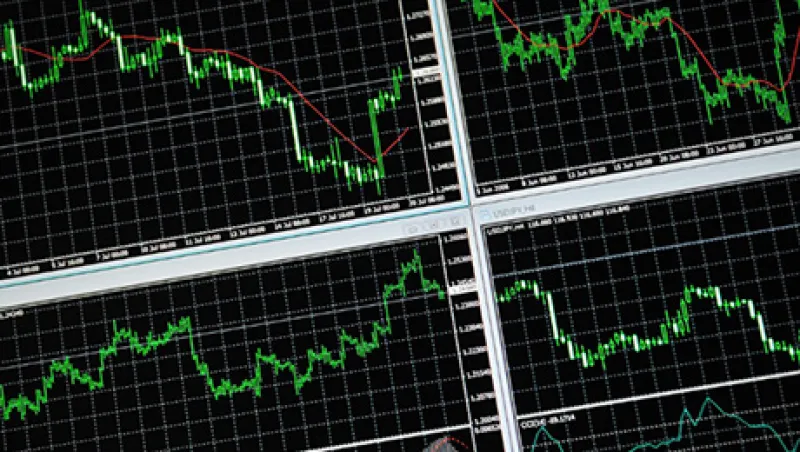I’ve been writing about the evolution in fixed-income trading for a number of years now, and investors repeatedly tell me that exchange-traded bond funds pose a particular threat in a crisis. The latest brouhaha erupted at CNBC’s and Institutional Investor’s Delivering Alpha conference in July when Carl Icahn blasted Larry Fink, CEO of BlackRock, saying the firm’s ETFs were partly responsible for the bubble in high-yield and could exacerbate market disruption if and when their investors want to sell. BlackRock, which has $129 billion in U.S. fixed-income ETFs, not only disagrees with Icahn’s view; it has been touting the funds as part of the solution to liquidity shortfalls.
Smaller transactions are increasingly taking place on electronic platforms, but most institutional investors still trade big blocks of bonds by calling a handful of their favorite dealers to get prices and then executing a trade with one of them. When banks were awash in borrowed money before the financial crisis, they kept plenty of bonds in inventory to make buying and selling almost instantaneous. Now that global regulators have rewritten the rules on capital requirements and virtually banned proprietary trading, banks are devoting much less of their precious capital to bond trading.
The financial industry is creative, though. Whereas banks have stepped back, the world of fixed-income trading has gotten something of a little Silicon Valley overhaul with technology and liquidity providers experimenting with a vast range of solutions.
Back to ETFs. Investors themselves have made big changes in how they’re managing their portfolios. When asset managers launched bond ETFs, I’m sure that few thought institutions and rival active bond managers would use them to get around liquidity challenges in underlying securities markets. But that is just what’s happening. Say, a high-yield manager receives new money from investors. Instead of going into the market right away, he or she can buy a high-yield ETF on an exchange — getting immediate exposure to the sector and avoiding the drag of cash — and then buy individual bonds over time. ETFs are a great alternative at a time when building a bond position can take months. Many investors are also holding bond ETFs as part of their liquidity cushion if shareholders want their money back in a crisis. In fact, Greenwich Associates found that 80 percent of institutional investors were using fixed-income ETFs for liquidity reasons.
Icahn and others charge that ETFs can’t provide more liquidity than the underlying bond markets. That sounds logical, considering that a high-yield or investment-grade ETF is just a bundle of bonds in that category. Those bundles, however, are traded on exchanges. Buyers and sellers can meet there without always touching the underlying securities. During times of stress, like the market meltdown of 2008 and the taper tantrum of 2013, trading in ETFs has been many times the volume in the underlying markets. That’s a good thing, as sellers trade their risks on the exchange. In contrast, traditional mutual funds are forced to sell securities when faced with redemptions.
“ETFs are not a panacea,” says Scott Eldridge, director of fixed-income product strategy at ETF provider Invesco PowerShares, “but they provide a cushion before you get to the place where someone is a forced seller.”
When the ETF market gets out of whack and the value of the underlying basket of securities doesn’t match the price of the ETF itself, so-called authorized participants step in. In the case of too much selling, the APs, who handle creations and redemptions, would buy up ETF shares and turn them over to the sponsor in return for a basket of bonds. The AP, who benefits from the ability to arbitrage between the ETF and underlying securities, can hold those until markets stabilize or decide to sell in the market.
Critics point to the premiums or discounts that ETFs can trade at as an indication of illiquidity in the underlying market. Better they should embrace ETFs as a tool of transparency. The exchange is publishing a real-time price for a fixed-income product. It’s an indication of the actual clearing price of the underlying securities. That’s a significant improvement over the actual bond market, which only publishes trade prices after the fact through a mechanism called TRACE.
Critics also contend that BlackRock and other ETF providers have created unprecedented demand for relatively illiquid high-yield bonds and other securities. That may be true in part. But investors have been piling into a range of products promising better returns, including traditional high-yield and bank loan mutual funds, credit hedge funds and business development companies that invest in private loans. These funds also pose liquidity risks. If anything, the popularity of ETFs, including bond funds, has been a by-product of the indexing craze.
Using fixed-income ETFs to circumvent broken fixed-income trading markets isn’t going away. More than likely, it’s growing. “The ETF structure solves for many of the challenges of trading individual bonds,” says Eldridge. “It comes down to education. Everybody needs to better understand what’s really going on.”
Follow Julie Segal on Twitter at @julie_segal.







